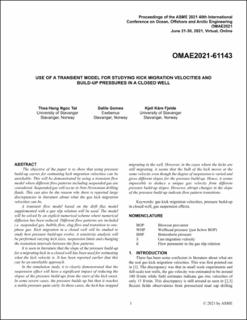| dc.contributor.author | Hang Ngoc Tat, Thea | |
| dc.contributor.author | Gomes, Dalila | |
| dc.contributor.author | Fjelde, Kjell Kåre | |
| dc.date.accessioned | 2023-03-01T09:03:13Z | |
| dc.date.available | 2023-03-01T09:03:13Z | |
| dc.date.created | 2021-11-24T13:57:46Z | |
| dc.date.issued | 2021 | |
| dc.identifier.citation | Ngoc Tat, T. H., Gomes, D., & Fjelde, K. K. (2021, June). Use of a Transient Model for Studying Kick Migration Velocities and Build-Up Pressures in a Closed Well. In International Conference on Offshore Mechanics and Arctic Engineering (Vol. 85208, p. V010T11A061). American Society of Mechanical Engineers. | en_US |
| dc.identifier.isbn | 978-0-7918-8520-8 | |
| dc.identifier.uri | https://hdl.handle.net/11250/3054859 | |
| dc.description.abstract | The objective of the paper is to show that using pressure build-up curves for estimating kick migration velocities can be unreliable. This will be demonstrated by using a transient flow model where different flow patterns including suspended gas are considered. Suspended gas will occur in Non-Newtonian drilling fluids. This can also be the reason why there is reported large discrepancies in literature about what the gas kick migration velocities can be.
A transient flow model based on the drift flux model supplemented with a gas slip relation will be used. The model will be solved by an explicit numerical scheme where numerical diffusion has been reduced. Different flow patterns are included i.e. suspended gas, bubble flow, slug flow and transition to one-phase gas. Kick migration in a closed well will be studied to study how pressure build-ups evolve. A sensitivity analysis will be performed varying kick sizes, suspension limits and changing the transition intervals between the flow patterns.
It is seen in literature that the slope of the pressure build-up for a migrating kick in a closed well has been used for estimating what the kick velocity is. It has been reported earlier that this can be an unreliable approach.
In the simulation study, it is clearly demonstrated that the suspension effect will have a significant impact of reducing the slopes of the pressure build-ups from the start of the kick onset. In some severe cases, the pressure builds up but then it reaches a stable pressure quite early. In these cases, the kick has stopped migrating in the well. However, in the cases where the kicks are still migrating, it seems that the bulk of the kick moves at the same velocity even though the degree of suspension is varied and gives different slopes for the pressure build-up. Hence, it seems impossible to deduce a unique gas velocity from different pressure build-up slopes. However, abrupt changes in the slope of the pressure build-up indicate flow pattern transitions. | en_US |
| dc.language.iso | eng | en_US |
| dc.publisher | American Society of Mechanical Engineers | en_US |
| dc.relation.ispartof | ASME 2021 40th International Conference on Ocean, Offshore and Arctic Engineering Volume 10: Petroleum Technology | |
| dc.title | Use of a transient model for studying kick migration velocities and build-up pressures in a closed well | en_US |
| dc.type | Chapter | en_US |
| dc.description.version | acceptedVersion | en_US |
| dc.rights.holder | The owners/authors | en_US |
| dc.subject.nsi | VDP::Teknologi: 500 | en_US |
| dc.identifier.doi | 10.1115/OMAE2021-61143 | |
| dc.identifier.cristin | 1958434 | |
| cristin.ispublished | true | |
| cristin.fulltext | postprint | |
| cristin.qualitycode | 1 | |
